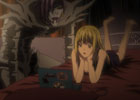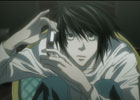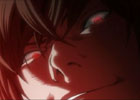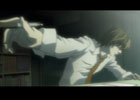Death Note
| Also Known As: dnote | ||
| Genre: Drama | ||
| Format: 37 Episodes | ||
| Allegiance: Madhouse | ||
| Director: Araki Tetsuro | ||
| Vintage: 2006 – 2007 | ||
| Intelligence Agency Report by: Miki | ||
| One day, genius high school senior Light Yagami spots a notebook that has fallen on the ground with the title “Death Note” written on the cover. He’s certain that the notebook and the rules scribed inside are some kind of joke, but the idea of being able to cleanse the world of its filth by simply writing the names of criminals is too good for Light to dismiss so easily. He tries the notebook, and shockingly, it works. The public loves Light, who they’ve nicknamed “Kira,” hailing him as a hero. The police, led by Light’s own father, and L, the greatest detective in the world, have to stop the vigilante slayings and bring Kira to justice. However, with no evidence or leads, whose “justice” will prevail? | ||
|
|
||
| Field Agent Report by: Miki | ||
| Plot Characters Impact Visual Audio |
8.50 9.50 9.75 9.75 9.75 |
|
| Overall | 9.25 | |
| (not an average) | ||
The only way to describe Death Note is as a 37-episode chess match. Drawing something like that out for so long requires many twists and turns, and it also requires all of its twists to be believable. This cat-and-mouse game between L and Light could be flawless in this regard, but it falls short in a couple very crucial ways.
First of all, even though there are a few genius characters that exist in the show, they sometimes reach conclusions they claim to be logical even though they sometimes seem contrived by the writer to advance the story or just show off the characters’ intelligence. While the latter is important, sometimes the show sacrifices keeping the viewer informed for the sake of the characters, leaving the viewer scratching their heads. Secondly, after the first two thirds or so of the show, the plot begins running out of steam. While still a solid story, it doesn’t quite reach the same level of intensity as the first part of the series.
Despite these flaws, the story is still spectacular. As Light/Kira and L creep ever closer to each other, the tension is very palpable. It becomes clear that both of them know what the other is thinking and going to do next, as well as knowing how to subvert the logic of the other. Situations arise that challenge them both to their limits and the plot builds and builds and builds until something absolutely has to break.
As for the characters, they are very well crafted and developed. For example, L is a super-genius and appropriately has odd quirks, among them his addiction to sweets, apparent insomnia, awkward handling of objects, and the unique way he sits in his chair. (relevance? “Eccentricity is often associated with genius, giftedness, or creativity.” source: http://en.wikipedia.org/wiki/Eccentricity_(behavior)) Smart characters are consistently smart, and dumb characters are… well, consistently dumb. Also, as the plot progresses, Light’s psyche is not left intact. This is a crucial element for the show as it moves into its later stages.
Visually and aurally this show is phenomenal. It makes use of a solid and very appropriate soundtrack. When you’ve got this much tension, you can expect some suspenseful and dramatic music. When you’ve got a character playing God, there’s a fair amount of chanting going on. The voice actors also do a great job, especially Mamoru Miyano (Gundam 00’s Setsuna, Ouran High School Host Club’s Tamaki, Wolf’s Rain’s Kiba) as Light and Kappei Yamaguchi (Inuyasha, Detective Conan’s Jimmy/Shinichi Kudo, Ranma ½’s Ranma) as L. They capture all the passion, patience, and cool calculation that those characters require.
The camera angles and movements used in this show are also something revolutionary. They take the seemingly most mundane actions like writing and even eating food and use obtuse angles and intense zoom-ins to show just how important they really are to what’s going on in the story, or how intense and important they are to the character carrying them out. Yes, eating food. It may sound undeserving of special focus or attention, but when you see it you understand. The character designs are very appropriate and drawn very well from all of the odd camera angles they use in the show, and it takes a really good artist to pull that off. Also, at his most emotional moments, the expressions displayed on Light’s face are absolutely terrifying. Credit for these factors goes to Obata Takeshi (Ayatsuri Sakon, Hikaru no Go), who inked them into the manga. The animation team did a perfect job translating the manga to anime form, using movement and color to really enhance the original drawings and bring them to life.
Death Note is one of the most popular anime in North America these days – and for good reason. It doesn’t disappoint, and if you decide to pass on this show because it seems overhyped, you’d be missing out on one of the best and most intelligent series to come out in the past few years.




